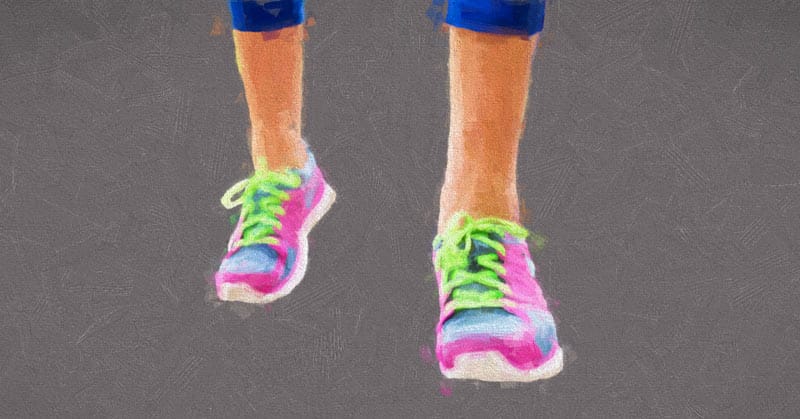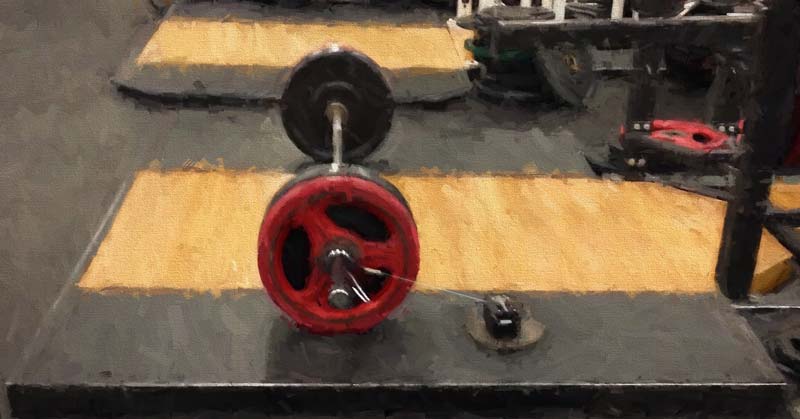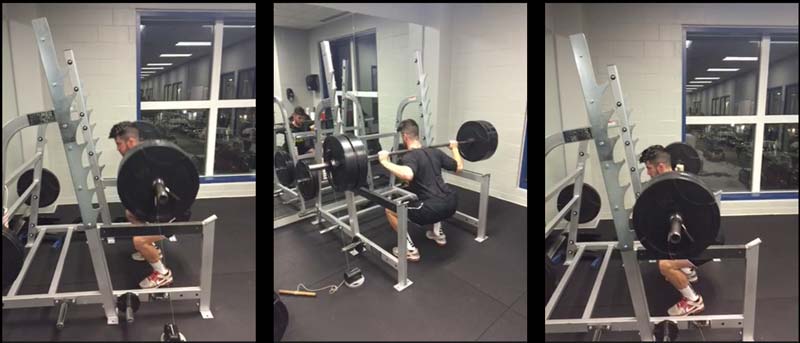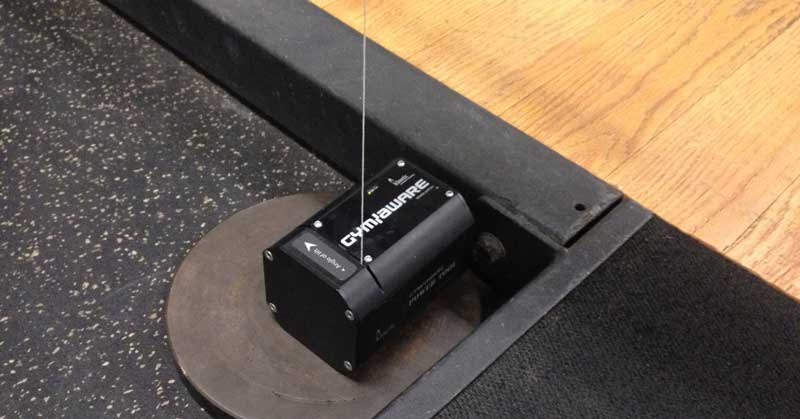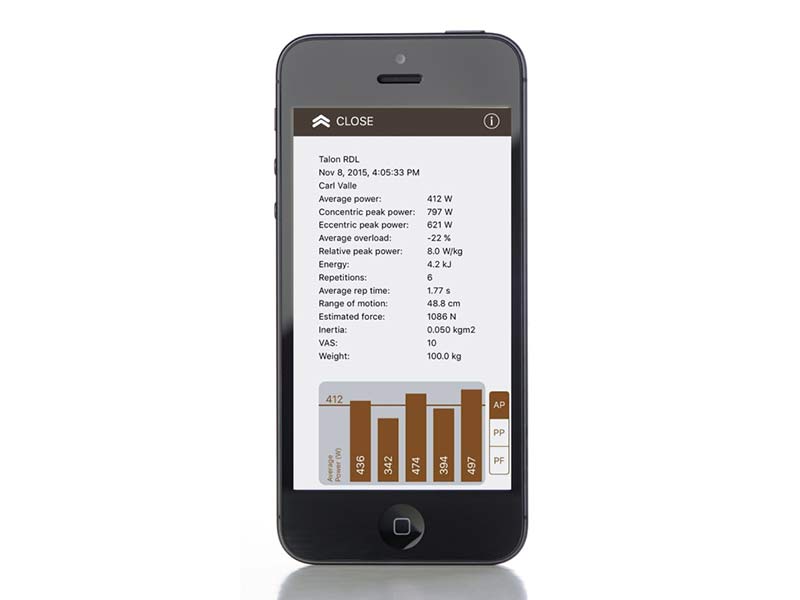![Greek Runners]()
By Pierre-Jean Vazel
This is the first time an historical progression of the highest speed ever recorded is published. Using bibliographical sources, including some unreleased data, it gives an account of the scientific challenge to record the human locomotion. Top speed is the parameter of the sprint races that is the most correlated with the final result, yet it has been the least investigated one. Indeed, for decades, science researchers have focused either on the start through biomechanical analysis or speed endurance with physiological studies, mainly for two reasons: top speed was thought to be not much trainable, and it is technically difficult to measure. Nowadays, it has become a centre of attention for coaches, media and fans.
“The top speed is seldom obtained until 40 yards,” wrote Ed James about sprinting in his Practical Training in 1877. But it took about 50 years before this top speed received enough attention to get quantified in flying runs or race breakdowns using either manual or electric timing. However, during the XXth century, it was hard enough to have an undisputable official timing of the races, let alone accurate measurements of the top speeds attained by the sprinters.
The first estimation of human’s top speed dates back to 1886 in Étienne-Jules Marey’s work as reported in the Weekly Reports of the Science Academy’s sessions: “The speed of progression increases indefinitely with the rapidity of cadence, and tends towards limits that seem to be around 10 meters per second.” The following recorded speeds mix biomechanical reports and more casual results, which sometimes lack precision and accuracy, especially the hand time splits which can be ‘too good to be true’, but I still chose to present them in respect to their historical significance.
![10.27 Meters Per Second]()
Charles Paddock (USA) Berkeley 31.03.1923
Hand timed in 8.9 for 100 yards from flying start (25 yards run-up). The 1920 Olympic champion at 100m ran the 100 yards in 9 4/5, just missing the then-World Record (9 3/5), and then decided to be timed in 100 yards from flying start, and also won the 220 yards by 10 yards in 21 1/5. Source: Berkeley Daily Gazette, 02.04.1923.
Paddock may have run faster for a shorter segment of races: he was officially hand-timed in 8 4/5 at 90 yards and 9 3/5 at 100 yards during an 110 yards race in 10 1/5 in Pasadena on 18 June 1926, beating or equalling World Bests. The 0.6 second time for the fastest 10 yards segment is an impossible 15,24 m/s and the 20 yards segment in 1.4 translates to a 13,06 m/s speed that is not reliable either. But given that the accuracy of hand timing back then was only 1/5 of a second, no credit can be given to such measurements. A time of 1.7 for 20 yards, hence 10.76 m/s would be closer to Paddock’s actual sprinting abilities.
![Charles Paddock]()
Charles Paddock
![10.48 Meters Per Second]()
Henry Russel (USA) Ithaca, NY Spring 1927
Electronically timed in 1.745 for 20 yards interval during a 200 yards race (straight lane) in 19.455. Coils of wire were arranged parallel to the track connected to a galvanometer and were placed at distances from the start of 1, 3, 6, 10, 15, 20, 40, 60, 80, 100, 120, 140, 160, 180 and 200 yards. The passage of a thin steel magnet on the runner’s jersey induced a current in the coil recorded by the galvanometer and printed on a moving photographic paper. The experiments were made with local sprinters at the Schoellkopf Field straight track at Ithaca’s campus, as part of Dr. Archibald Vivian Hill’s series of a lectureship in chemistry at Cornell University from February to June 1927. Hill received the Nobel Price in Physiology or Medicine in 1922 for “his discovery relating to the production of heat in the muscle”. Source: Furusawa et al. The dynamics of sprint running, 1928. “Hank” Russell’s personal bests stood as 9.7 at 100 y (1926), 10.7e at 100 m (1928), 21.5 at 220 y and 21.4 for the straight course (1926) and he became Olympic champion at 4×100 m and reached the 100m semi-final at 1928 Games. Coincidentally, the 100m winner Percy WILLIAMS (CAN) was the subject of a similar experiment by Dr. Charles Best in an indoor track in Toronto, and the sprinter, wearing short spikes, reached 10.44 m/s as he was timed in 0.438 for a 5 yards section during a 65 yards race in 7.00.
![Henry Russel]()
Henry Russel
![10.88 Meters Per Second]()
Cyrus Leland (USA) Forth Worth 20.05.1930
Timed in 8.4 for 100 yards from a flying start, according to an electrical device. No details were given about how this apparatus was operating, but stopwatches caught him at 8.7, which improved the World Best set by Paddock anyway. The 8.7 figure translates to a 10.51 m/s. Source: Pampa Daily News, 21.05.1930. Texas Christian University’s Leland set the fastest 100 y time of the year in 9.4w and ran 9.6 for 101 y on 29 March in Dallas as he was set back one y for a false start! That cost him about a tenth when the World Record was 9.5. Leland already matched this time in 1929 at the TCU – Baylor match, but the record was not ratified as dual meets were not eligible for permanent listing.
![11.66 Meters Per Second]()
Ralph Metcalfe (USA) 1932-33
During a 100 m race after 70 m. Fastest speed found in the literature by Prof. Otto Misangyi, former national coach for Hungary and Switzerland, head of the jury of time-keeps at 1932 and 1936 Olympic games. But no further detail or reference is given. Source: Misangyi O. Reaction time and speed measurement in sprint and hurdle races, Magglingen, 1956.
Metcalfe placed 2nd at 1932 Olympics, 5 cm behind the winner Eddie Tolan. Tolan was timed in 10.3 by the three official hand timers, but oddly enough, Metcalfe got 10.3 on all three… The Official Report of the games also gives other times for the race: 10.21 by the “hand electrical” method (started by an attachment on the starter’s gun and stopped by hand at the time the runners hit the tape), and 10.38 by a camera device called Kirby Two-Eyed Camera, operating at 128 frames/sec while filming runners and an electric clock started by the gun.
In his book Champion in the Making (1968), coach Payton Jordan stated that Eddie Tolan “took six strides (six feet per stride – 1.83 m) in covering the ground at the rate of 36 feet per second”, which is 10.97 m/s. This comes from an estimation by Goeffrey Dyson (Chief National Coach at the Amateur Athletic Association from 1947 to 1961) in his book The Mechanics of Athletics, London, 1962) : “Clearly, an athlete striding only 6 ft at top speed (as E. Tolan, winner of the 1932 Olympic 100 meters is reported to have done) must take as many as six strides in covering 36 ft in one second.” Tolan’s 6 feet stride length had been reported by Jesse Owens’ coach Larry Snyder in Specifications or Requirements of the new 100 meter champion, Olympic Review no. 8, 1940.
Olympic Games, Berlin, Germany, 3rd August 1936, Men’s 100 Metres Final, USA’s Jesse Owens (Extreme right) wins the race from Ralph Metcalfe (USA) and Dutchman Martinus Osendarp in a time of 10,3 seconds to equal the world record.
![10.88 Meters Per Second]()
Jesse Owens (USA) Colombus 23.04.1935
Hand timed in 8.4 by three watches for 100 yards from flying start (20 yards run-up). The event took part 1 month before the intercollegiate meet in Ann Arbor where Owens broke 5 World Records in 45 minutes and also matched the 100 yards World Record in 9.4 as recorded by three watches. But the time could have been better: three other timers in reserve had him 9.3. Also, during that meet, times were taken as the runner’s center of gravity crossed the line, adding 0.1 to the traditional timing to the torso. Owen’s 9.4 stood 13 years as a World Record, but 9.3 would have last 26 years and 9.2, 28 years!
Olympic Games, Berlin, Germany, Men’s 100 Metres Final, USA’s legendary Jesse Owens on his way to winning one of his four gold medals.
![11.10 Meters Per Second]()
Vladimir Volikov (URS) Kharkiv 27.07.1936
Electronically timed in 0.36 for the 4m interval between 44 and 48 m during a 100 m race in 11.15. Times were recorded to the 1/200th of a second every time the runner cuts yarns attached to poles placed every 4 m along the track. The experiments were held during the summer with several sprinters and non-sprinters. Volikov’s 100 m was one of the few whose 4m interval speeds varied during the race, with ups and downs from 24 m: 9.2, 10.4, 9.3, 9.4, 10.6, 9.5, 11.1, 9.9 m/s. It was suggested by the Simonson, the German author of the study, that those peaks are the expression of powerful motor efforts that can’t be sustained because of fatigue in the motor cortex or peripheral areas. Simonson eliminated flaws in the measurement apparatus as those peaks, when they occurred, weren’t located in the same portion of the race. However, the interval times would be affected whether the arms or the legs cut the yarns instead of the torso or hips, depending on the height of the timing system. Another explanation would be the fact that the sprinter is decelerating during the breaking phase of each step and accelerating after the push phase, as it were later recorded using spidograms and nowadays using laser devices. Source: Simonson E. Laboratory of Physiology, National Institute of physical culture of Ukraine, 1937. Little is known about Volikov as he never took part to international competition – USSR made its debut at the Olympic Games in 1952.
![11.11 Meters Per Second]()
Harold Davis (USA) Compton 06.06.1941
Hand timed in 4.5 for the last 50 m of a 100 m race in 10.2 by his coach ‘Bud’ Winter. The 100 m time as announced officially the night of the race was 10.3, but the officials disclosed the next day that Davis actually tied the world record of 10.2 set by Owens. The three timers on duty had 10.2, 10.2 and 10.3 and the alternate had 10.4, the latest should not have been taken into account. Sources: Quercetani R. A World History of Track and Field Athletics, 1864-1964, Oxford University Press, 1964; Associated Press, Decide Davis tied world dash record, 07.06.1941.
![11.33 Meters Per Second]()
Vladimir Sukharev (URS) Minsk 26.08.1951
Speed between 45 and 50 m during a 100 m race in 10.4 recorded using a cinematographical device taking splits every 5m. Sukharev then maintained an 11.11 m/s speed until 65m. The accuracy of the times was 0.02 s. During the same summer, he was hand timed at training for various distance from flying start: 30m in 2.7 (11,11 m/s), 40 m in 3.7 (10,81 m/s), 50 m in 4.6 (10.87 m/s), 60 m in 5.8 (10.34 m/s) and 80 m in 7.7 (10.39 m/s). Source: Chomenkov L. 100 m and 200 m races, Moscow, 1955.
![12.04 Meters Per Second]()
Bob Hayes (USA) Atlanta 12.05.1962
Hand timed in 1.9 between 50 and 75 yards during a 100y race in 9.3 at SIAC Championships. Two years after the race, Sports Illustrated published 25y splits for that race: 3.0 at 25 yards, 2.2 between 25 and 50 yards (10.39 m/s), 1.9 between 50 and 75 yards (12.04 m/s), 2.1 in the last 25 yards (10.89 m/s). The sum of these 25 yards splits adds up to 9.2, as there was controversy regarding the final time of the race: “Among the judges, presumably atremble at the sight, there were watches stopped at 8.9 seconds and 9.0 seconds. This was impossible, of course. Nobody would ever believe such a thing. Hayes’s time rounded off to a sensational but uninflammatory 9.3 seconds.” Source: Underwood J. How fast is the fastest man alive? Sports Illustrated, 18.05.1964. The official World Record was then 9.2, held conjointly by Frank Budd (in 1961) and Harry Jerome (twice in 1962). This was one out of many World Records denied to Bob Hayes due to technical rules or dodgy timing.
In Modesto on 26.06.1962, Bob Hayes reached 11.72 m/s speed as he was hand timed in 7.8 for the last 100 yards of a 4×110 yards anchor leg. Source: Allen N. World Sports magazine, April 1963.
In Modesto on 25.05.1963, Hayes reached 11.43 m/s as we were hand timed in 8.8 for his 110 yards anchor leg. Source: Interview with Hayes in A.A.U. News, vol 34, 1963: “They tell me I ran 8.8 for 110 yards with a flying start in that Modesto race” – Report states that Hayes received the baton 10 yards behind the leader and won with a seven-yard margin. However, the accuracy of this hand timing is unknown.
In Saint-Louis on 21.05.1963 (1st semi-final of AAU Championships), Hayes was supposedly hand timed in 3.0 at 25 yards, 6.0 at 60 yards, 7.1 at 75 yards during the 100 yards in 9.1 (World Record, wind +0.85 m/s), also electronically timed in 9.40. From 25 to 60 yards, he moved at 10.67 m/s, from 60 to 75 yards 12.47 m/s (!) and from 75 to 100 yards 11.43 m/s. Source: Willoughby D. The Super-Athletes, Barnes & co., 1970. It is not clear whether these times were estimations or actual times, but as inaccurate as it can be, the speed in the 60-75 yards was used in The Guinness Book of Records for years as the fastest speed ever recorded by a human.
Various times were reported for his anchor leg during the 4x100m Olympic final Tokyo on 21 October 1964, from an 8.5 hand time to a 9.1 video estimation by Galina Turova (Legkaya Atletika 3/1965) on her technical analysis, which would be an average speed ranging from 10.99 to 11.76 m/s! From my video analysis of a Polish film and another footage with incrusted screen timing, Hayes ran 9.0e, he took the baton circa 0.15 after Dudziak/POL (10.52 in the individual event) and won by 0.30 over him. The last 40m were covered between 3.40 and 3.45 with 2.40 m step length, translating to a top speed over 11.7 m/s.
Bob Hayes became the first man to run under 10 seconds electronically with 9.91w in the semi-final of the 1964 Olympic Games in Tokyo. In the final, he ran a wind-legal 10.00 or 10.01 depending which of the 2 photo finishes you trust, a time that was corrected to 10.05 or 10.06 taking in account an estimated delay of 0.05 in the electric timing mechanisms used in the ‘60s and 10.06 became the accepted figure from the late ‘70s.
American athlete Bob Hayes (1942 – 2002) takes off from the starting blocks as he sprints for Florida A&M University (FAMU), early 1960’s.
![11.95 Meters Per Second]()
Tommie Smith (USA) San Jose 07.05.1966
Timed in 1.53 for the last 20 yards of his 220 yards world record (19.5, wind +1.84 m/s). Source: Patinaud JC. 200 mètres & 220 yards, Temps automatiques 1932-1983. No details are given regarding the timing procedure. It’s unlikely that there was an electric timing that day, since even the official hand times of the race lack accuracy : at 200 m, the three timers had 19.4, 19.5 and 19.6, and at 220 yards (201.17 m), times were 19.5, 19.5 and 19.6, thus the 19.5 figure was accepted as a World Record for both distances! The statistic difference between 200 m and 220 yards hand times used in world lists is 0.1 and 0.12 for electric times.
His coach Bud Winter gave a measurement of Smith’ stride during the last stage of that race from the footprints on the cinder track: “At 120 yards out, Tommie’s stride measured 8’5″ (2.57 m) up to 20 yards from the finish then it increased to 8’7″ (2.62 m). In his last three strides, it measured 8’9” (2.67 m).” Source: Amateur Athlete, AAU, vol. 37 p. 70, 1966.
Video 1. Tommie Smith runs 200 meter straight.
Quoted by Time magazine (Jetting into Gear, Vol 89 Issue 10 p. 88, March 1967), Bud Winter stated that Smith was able to run at 11,64 m/s: “Other sprinters reach their top speed at 75 yds, and then decelerate,” says his coach, Lloyd (“Bud”) Winter, “Tommie is still accelerating at the end of 100 or 220 yds. He can sustain a speed of 26 m.p.h.”
Tommie Smith (right) of the USA wins the men’s 200 metres final at the Olympic Games in Mexico City, 16th October 1968. Bronze medallist John Carlos, also of the USA is on the left. Smith and Carlos later caused controvery when they gave the black power salute on the medal podium.
![11.72 Meters Per Second]()
Valeriy Borzov (URS) München 01.09.1972
Timed in 1.56 for two consecutive 9,14 m (10 yards) intervals between 58,56 m and 76,84 m using the markers on the track for the 110 m hurdles, during the 100 m Olympic final won in 10.14 (win -0.3 m/s). Intermediate times were taken from video recordings by East German scientist Heinrich Gundlach. The report states that the error margin was +/- 0.02 s due to picture frequency; however, a second person examined the videotapes to limit the subjective factor in the allocation of times and distances. Source: Gundlach H. Olympische Leichtathletik-Wettkämpfe 1972: Dokumentation, Einschätzungen, Bildreihen, Leipzig, 1973.
Italian coach Carlo Vittori also analyzed a film of the race using the 110m hurdles markers as references, but no details are given about the frame frequency or error margin. He found that Borzov’ speed reached 11.484 m/s as he ran a 9,44 m interval between 48,83 m and 58,27 m in 0,822 s. However, these distance references don’t exist on the track and accuracy to the 0.01, let alone 0.001 s was unlikely to be obtained from a video. Source: Vittori C, Dotta GF. Analisi ritmica della finale dei 100 m. Alle olimpiadi di Monaco ’72 vinta da V. Borzov. Atleticastudi, Mar-Apr 1985.
Earlier in 1972 on 18 July, Borzov reached 11.68 m/s between 45 and 50m and 11.61 m/s between 70 and 75 m during the 100 m final of the USSR championships in 10.0 (10.28 from video timing, wind < 2.0 m/s). The method used by Pr. Dmitriy Ionov for the time analysis was very similar to the one described for Sukharev in 1951 but the precision of the time was higher. Source: Mehrikadze V. The purpose of competitive training model, Legkaya Atletika, no. 8, 1982.
![11.78 Meters Per Second]()
Steve Williams (USA) Zürich 24.08.1977
Four strides were filmed at the 70m mark by a 16 mm Locam camera (100 fps) during a 100 m won by Williams in 10.16 (wind -1.5 m/s). Total distances and time of the four strides for the top three finishers were presented in a graph format in a scientific paper. Pr Hansruedi Kunz sent me the actual numbers and resulting speed for Williams: Stride length 2.65 m, time for four strides 0.83 (4.82 s/s). However, these figures don’t match with 11.97 m/s speed as they would result in 12.77 m/s. Unfortunately, the author has lost the original data and believes the speed is correct, and there must be a typo mistake either in the stride length or frequency. A four stride time of 0.90 (4.44 s/s) which appeared in the graph would be more accurate and would result in 11.78 m/s speed. Sources: Kunz H. Biomechanical analysis of sprinting: Decathletes versus champions, Brit. J. Sports Med. Vol. 15, No. 3, p. 177-181, 1981 and personal communication with the author.
In Minsk on 21 July 1973, Williams reached 11.63 m/s between 60 and 65 m during a 100 m in 10.1 (10.21 video time, wind < 2.0 m/s) according to Pr Ionov’s analysis. At this point of the race, his stride length was 2.54 m and frequency was 4.58 s/s. Source: Mehrikadze V. The purpose of competitive training model, Legkaya Atletika, no. 8, 1982.
![11.82 Meters Per Second]()
“Lane 2” (USA) Colorado Springs Summer 1978
Two strides were filmed at 50 m from the start, using an LICAM 16 mm camera at 150 fps during a training camp sponsored by the USOC Development Committee. Twelve U.S. sprinters with lifetime bests that ranged from 9.9 to 10.4 participated to a study about physical and performance characteristics of male sprinters. The identity of the fastest one, “Lane 2”, can’t be revealed because of a ‘confidentiality agreement’ that prevents the public release of the names of athletes studied. The average length for the two strides filmed was 2.52 m, and stride frequency was 4.68 s/s. Taking into account the displacement of his center of gravity, his speed was 11.73 m/s. The author, Pr. Anne Atwater, noted that the group that attended the 1978 camp ran much faster than during the 1979 camp: “1978 Sprinters seemed more motivated as they each raced directly against two other sprinters and as they were not required to run the entire 100 m distance.” Altitude might have played a role since the 1978 camp was held at 1800 m, and no indication was given regarding the effect of the wind. Source: Atwater A. Kinematic Analysis of sprinting, Biomechanics Symposium, Indiana University, Bloomington, IN, October 1980, and personal communication with the author.
![11.90 Meters Per Second]()
Calvin Smith (USA) Karl-Marx-Stadt 09.07.1982
Fastest 10 m interval during the anchor leg of a 4×100 m relay in 38.22 during the USA v GDR match. His fastest 30 m section was 2.54, timed by several cameras with digital timers activated by the official timing system, placed along the track. This was faster than during the 100 m race he won earlier in the day in 9.91, faster than the 9.95 by Jim Hines in 1968) but the wind was measured at 2.1 m/s, just over limit for World Record application. During this race, he was timed in 2.56 in the 30-60 m section (11.72 m/s) and 1.72 in the 60-80 m section (11.76 m/s). However, during Smith’s relay leg, the wind was under 2.0 m/s according to the East German report. Source: Hess WD. Aspects of the development in sprint and hurdles events in the Olympic cycle 1981/84, Leipzig, 1985.
Calvin Smith (right) of the United States narrowly beats British athlete Allan Wells (42) to the finish line during the 100m race at the Amateur Athletics Association Championships at Crystal Palace, London on July 23rd 1983.
![12.04 Meters Per Second]()
Ben Johnson (CAN) & Carl Lewis (USA) Seoul 24.08.1988
Timed in 0.83 for a 10 m section during a 100 m in 9.79 for Johnson (later disqualified for doping) and in 9.92 for Lewis at the Olympic final (wind +1.1m/s). Intermediate times were given to the media by Swiss Timing and were later published by Omega in the booklet Athletics Full Results Seoul 1988. Those splits differ from the times published by IAF in the Final Report of the Scientific Research Project made by Moravec & Susanka from Prague Charles University (also in charge of 1987 World Championships analysis). This analysis “was done on the basis of recordings from five video cameras (50 fps) and five high speed (200 fps) film cameras”, says the IAF report, while Omega gives no details as how they came up with 10 m splits. The Omega times make no sense regarding the evolution of the race, and analysis with today’s video software analysis possibilities match with the times reported by IAF.
Canadian sprinter Ben Johnson competing in the 100 Metres semi-final at Seoul Olympic Stadium during the Olympic Games in Seoul, South Korea, 24th September 1988. Johnson won the final in a world record time of 9.79 seconds, but was disqualified for doping.
Table 1. 10-meter splits for Carl Lewis and Ben Johnson at 1988 Olympics in Seoul.
| 10-Meter Splits of 100-Meter Dash |
| Carl Lewis |
| IAF Report |
| 1.89 |
2.96 |
3.90 |
4.79 |
5.65 |
6.48 |
7.33 |
8.18 |
9.04 |
9.92 |
| 1.89 |
1.07 |
0.94 |
0.89 |
0.86 |
0.83 |
0.85 |
0.85 |
0.86 |
0.88 |
| Omega |
| 1.97 |
3.00 |
3.89 |
4.81 |
5.65 |
6.53 |
7.37 |
8.23 |
9.06 |
9.92 |
| 1.97 |
1.03 |
0.89 |
0.92 |
0.84 |
0.88 |
0.84 |
0.86 |
0.83 |
0.86 |
| Ben Johnson |
| IAF Report |
| 1.83 |
2.87 |
3.80 |
4.66 |
5.50 |
6.33 |
7.17 |
8.02 |
8.89 |
9.79 |
| 1.83 |
1.04 |
0.93 |
0.86 |
0.84 |
0.83 |
0.84 |
0.85 |
0.87 |
0.90 |
| Omega |
| 1.95 |
2.93 |
3.81 |
4.69 |
5.52 |
6.37 |
7.22 |
8.06 |
8.93 |
9.79 |
| 1.95 |
0.98 |
0.88 |
0.88 |
0.83 |
0.85 |
0.85 |
0.84 |
0.87 |
0.86 |
In Rome on 30.08.1987, both Johnson (later disqualified) and Lewis reached 12.04 m/s for 10 m in the 100 m final (wind +1.0 m/s) according to the Fast results were available during the World Championships. The times were later corrected in the Scientific Report published by IAF, and their best 10 m turned out to be 0.85, hence 11.76 m/s.
Table 2. 10-meter splits for Carl Lewis and Ben Johnson in Rome, 1987.
| 10-Meter Splits of 100-Meter Dash |
| Carl Lewis |
| Fast Results |
| 1.94 |
2.97 |
3.92 |
4.77 |
5.67 |
6.50 |
7.33 |
8.23 |
9.09 |
9.93 |
| 1.94 |
1.03 |
0.93 |
0.85 |
0.90 |
0.83 |
0.83 |
0.90 |
0.86 |
0.84 |
| Scientific Report |
| 1.94 |
2.96 |
3.91 |
4.78 |
5.64 |
6.50 |
7.36 |
8.22 |
9.07 |
9.93 |
| 1.94 |
1.02 |
0.95 |
0.87 |
0.86 |
0.86 |
0.86 |
0.86 |
0.85 |
0.86 |
| Ben Johnson |
| Fast Results |
| 1.86 |
2.87 |
3.80 |
4.66 |
5.55 |
6.38 |
7.21 |
8.11 |
8.98 |
9.83 |
| 1.86 |
1.01 |
0.93 |
0.86 |
0.89 |
0.83 |
0.83 |
0.90 |
0.87 |
0.85 |
| Scientific Report |
| 1.84 |
2.86 |
3.80 |
4.67 |
5.53 |
6.38 |
7.23 |
8.10 |
8.96 |
9.83 |
| 1.83 |
1.02 |
0.94 |
0.87 |
0.86 |
0.85 |
0.85 |
0.87 |
0.86 |
0.87 |
In Tokyo on 25.08.1991, Carl Lewis reached the same 12.04 m/s for a 10 m split during the World Championships 100 m final (wind +1.2 m/s) he won in a new World Record. Ten video cameras (60 fps) were located at 10 m intervals along the home straight of the stadium and the error allowance was +/- 0.02 seconds, according to the preliminary report published in New Studies in Athletics. Thus the 0.83 interval figure could also be a 0.84 (11.90 m/s) taking in account the accuracy level:
Table 3. Carl Lewis in Tokyo, 1991.
| 10-Meter Splits of 100-Meter Dash |
| Fast Results |
| 1.88 |
2.96 |
3.88 |
4.77 |
5.61 |
6.46 |
7.30 |
8.13 |
9.00 |
9.86 |
| 1.88 |
1.08 |
0.92 |
0.89 |
0.84 |
0.85 |
0.84 |
0.83 |
0.87 |
0.87 |
During the quarter finals of these 1991 World Championships, Carl Lewis was timed in 0.80 for 10 m, 12.50 m/s speed, for a 100m time in 9.80 but the wind was blowing at 4.3 m/s.
Sources: Ae M & al. (1992) The men’s 100 meters, In: The Scientific Research Project at the III World Championships in Athletics: Preliminary reports. New Studies in Athletics, no. 1, March 1992; Ae M & al. (1994) Analysis of racing patterns in 100m sprint of the world’s best sprinters, In Japan Association of Athletics Federations (ed.), The Techniques of the World Top Athletics (Research Report of the 3rd World Championships, Tokyo) Tokyo: Baseball Magazine Co.
In Los Angeles on 04.08.1984, Carl Lewis was supposedly timed at 28 miles per hour (12.51 m/s) for his last 2 m of the 100 m Olympic final won in 9.99 (wind +0.2 m/s) according to Swiss Timing, as reported by Track & Field News magazine (October 1984 issue). No details were provided regarding the method, precision, and accuracy of this measurement.
![12.01 Meters Per Second]()
Donovan Bailey (CAN) Atlanta 27.07.1996
Peak speed located at 50 m recorded by a laser device operating at 50 Hz during the 100 m Olympic final won in 9.84 (World Record, wind +0.7 m/s). For the first time, the system Laveg (Laser Velocity Guard) was used in an international competition. Like the spidograms released in USSR in the early 1950s, the laser records velocity oscillations that occur during each stride that allows counting the number of steps. Smoothing the curve is necessary to obtain an average speed over several steps. A raw graph format using a “factor 7” smoothing shows velocity curve shows a range between 11.2 m/s and 12.7 m/s within stride cycles in the 50-60 m section in Bailey’s 100 m race. A speed curve graph appeared on TV within seconds after the final, showing a 12.1 m/s at 59.8 m. A “factor 49” smoothing, used in the final report, gives 12.01 m/s at 50 m and two other peaks very close to 12 m/s at about 53 and 59m. Sources: Türk-Noack A. LAVEG-Analyse of the 100 m sprint; Laser speed measurement for analyzing translational movements. Symposium of the athletics, Bad Blankenburg, 2002.
Another interpretation of this Laveg measurement is found in Grosser M, Renner T. Schnelligkeitstraining, BLV Buchverlag, Munich, 2007. Bailey’s top speed is still 12.01 m/s but it is now located at 54.55 m after 5.95 s into the race!
The authors also give 10 m splits from the smooth curve which result in a speed of 11.90 m/s for Bailey’s fastest interval.
Table 4. Donovan Bailey in Atlanta, 1996. Laveg Laser Velocity Guard.
| 10-Meter Splits of 100-Meter Dash |
| 1.90 |
2.93 |
3.84 |
4.71 |
5.55 |
6.39 |
7.24 |
8.09 |
8.95 |
9.84 |
| 1.90 |
1.03 |
0.91 |
0.88 |
0.84 |
0.84 |
0.84 |
0.85 |
0.86 |
0.89 |
Note that the 10 m intervals times don’t add-up exactly with the intermediate times. The reason in that these times are calculated and rounded from the average speeds for each interval by the Laveg software.
The full accuracy times are questionable in that the times at 40 m published by Grosser and Renner don’t correspond to the distances shown in photographs taken from the stands by Pascal Rondeau for Allsport Agency (the yellow marks are located at 38.5 m from the start and the white marks at 40.28 m). Fredericks (lane 5) was timed in 4.69, Mitchell (lane 4) in 4.70 and Boldon (lane 3) in 4.71. It’s disputable that Bailey (lane 6) would also been given 4.71 from these pictures:
A general view of the men’s 100m finals won by Donovan Bailey of the Canada at the Olympic Stadium at the 1996 Centennial Olympic Games in Atlanta, Georgia. \ Mandatory Credit: Pascal Rondeau /Allsport
An analysis of Bailey’s run was also published in China by Feng Dengshou. Technical characteristics of Bailey’s World Record setting 100m running, Sport Science Research, Vol.17, no.4, Dec. 1996. But the intermediate times are quite different and no details are given regarding the methodology:
Table 5. Donovan Bailey in Atlanta, 1996. Feng Dengshou Analysis.
| 10-Meter Splits of 100-Meter Dash |
| 1.87 |
2.96 |
3.89 |
4.78 |
5.62 |
6.45 |
7.28 |
8.12 |
8.98 |
9.84 |
| 1.87 |
1.09 |
0.93 |
0.89 |
0.84 |
0.83 |
0.83 |
0.84 |
0.86 |
0.86 |
Sources: Türk-Noack A. LAVEG-Analyse of the 100 m sprint; Laser speed measurement for analyzing translational movements. Symposium of the athletics, Bad Blankenburg, 2002.
![12.04 Meters Per Second]()
Tyson Gay (USA) Eugene 28.06.2008
Timed in 1.66 for 20m (two consecutive 0.83 intervals) between 50 and 70 m during the 100 m U.S. National championships quarter-final won in 9.77 (wind +1.6m/s), using four videos recorded by cameras showing the flame of the gun and placed in the upper stands at the 50, 55, 60 and 70 m marks. Source: time analysis through the video material by Pierre-Jean Vazel.
Tyson Gay of the United States reacts after crossing the finish line in the Men’s 100 metres semi-final during day two of the 15th IAAF World Athletics Championships Beijing 2015 at Beijing National Stadium on August 23, 2015 in Beijing, China.
![12.20 Meters Per Second]()
Usain Bolt (JAM) Beijing 16.08.2008
Timed in 0.82 for 10 m between 60 and 70 m during the Olympic 100 m final won in 9.69 (World Record, wind 0.0 m/s) using videos (50 or 60 fps) recorded by camera showing the flame of the gun and placed in the upper stands in either sides of the stadium at the 10, 30, 60 and 90 m marks, as well as with TV replays including a travelling view. Other intermediate times were calculated from the intervals of the men and women’s hurdles marks on the track. Several time analyses flourished on the internet but it’s unlikely that they were based on in situ video recordings of the race. Source: time analysis through the video material by Pierre-Jean Vazel.
August 16, 2008, Usain BOLT of Jamaica sets the world record at 9.69 when he wins the 100 m dash final at the National Stadium on the Olympic Green at the XXIX Olympiad in Beijing on Saturday. Toronto Star/Steve Russell (Photo by Steve Russell/Toronto Star via Getty Images)
Table 6. Usain Bolt in Beijing, 2008.
| 10-Meter Splits of 100-Meter Dash |
| 1.84 |
2.87 |
3.78 |
4.65 |
5.49 |
6.32 |
7.14 |
7.97 |
8.81 |
9.69 |
| 1.84 |
1.03 |
0.91 |
0.87 |
0.84 |
0.83 |
0.82 |
0.83 |
0.84 |
0.88 |
![12.35 Meters Per Second]()
Usain Bolt (JAM) Berlin 16.08.2009
Peak speed located at 67.90 m by the Laveg system during the World Championships 100 m final won in 9.58 (World Record, wind +0.9 m/s). The analysis was performed by Eberhard Nixdorf (Olympiastützpunkt Hessen at Frankfurt) and this result published in the final report in 2011 is slightly different compared to the preliminary report given via the IAAF to the media the day after the race which also included top speed and calculated 10 m intermediate times.
Table 7. Usain Bolt in Berlin, 2009.
| 10-Meter Splits of 100-Meter Dash |
| Scientific Research Report issued on 17.08.2009 at 8:00 pm |
| 1.89 |
2.88 |
3.78 |
4.64 |
5.47 |
6.29 |
7.10 |
7.92 |
8.75 |
9.58 |
| 1.89 |
0.99 |
0.90 |
0.86 |
0.83 |
0.82 |
0.81 |
0.82 |
0.83 |
0.83 |
Maximum velocity: 12.27 m/s at 65.03 m
Table 8. Usain Bolt in Berlin, 2009.
| 10-Meter Splits of 100-Meter Dash |
| Biomechanical Analysis of the Sprint & Hurdle Events, New Studies in Athletics, 2011 |
| 1.88 |
2.88 |
3.78 |
4.64 |
5.47 |
6.29 |
7.10 |
7.92 |
8.74 |
9.58 |
| 1.88 |
1.00 |
0.90 |
0.86 |
0.83 |
0.82 |
0.81 |
0.82 |
0.82 |
0.84 |
Maximum velocity: 12.35 m/s at 67.90 m (0.81 = 12.35 m/s)
The raw speed curve of the Laveg recording showed variations between 11.7 and 13.2 m/s during the stride cycles in the 50 and 60 m of the race.
The race was also filmed by 50 fps camera with digital timers activated by the official timing system, placed along the track at 20 m, 40 m, 60 m and 80 m. It provided frames every 0.02 seconds and the missing frame was extrapolated in order to get 0.01 second times. The analysis was led by Rolf Graubner (fgs Halle-Wittenberg) and given to the IAAF the day after the race:
2.89 – 4.64 – 6.31 – 7.92 – 9.58
(1.61 for 20 m = 12.42 m/s, fastest 10 m would be 0.80 = 12.50 m/s).
These intermediate times might be more accurate than the Laveg calculation since video frames are similar to photo finish pictures as the times “shall be taken to the moment at which any part of the body of an athlete (i.e. torso, as distinguished from the head, neck, arms, legs, hands or feet) reaches the vertical plane of the nearer edge of the finish line”, as per IAAF Rule 165.2. From 1913 until 1953, it was required that the entire body be across the line for a finish, which is practically the same as the Laveg system, since the back is usually the targeted part of the body.
The different figures for Usain Bolt’s top speed in the same race using video and laser timing measurement show how difficult it is to get a precise and accurate figure of sprinting maximum velocity, and this will remain a big challenge for the future.
I would like to thank Anne Atwater, Rolf Graubner and Hansruedi Kunz for their insights and explanations regarding their respective scientific research. Any corrections, amendments and proposals are welcome as this list is the first draft.
Please share so others may benefit.
